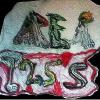Dam it guys, you beat me to the punch.

I also found this info a few days ago and was going to share it. Well at lease now I know that there are still people interested on this thread besides me.

Anyhow, I also found some interesting things while looking for information about IGF-1.
These things have a positive effect on IGF-1:
Cinnamon
A friend of mine has diabetes type 1, and neither cinnamon tea nor cinnamon pills seem to work for him. However, a family member has type 2 diabetes and they do have an improvement of glucose levels with cinnamon tea and pills. This has made me wounder if the reason is the effect of Cinnamon on IGF-1, because people with type 1 diabetes have a IGF-1 deficiency.
Capsaicin
It's cheap I'm getting myself some cayenne pepper.
Ursolic Acid
The downside is that the extract is to expensive, and most options out there don't have a high level of concentration making the user have to take multiple capsules each serving. The best option is powder form which is Ursolic Acid 25% from a Loquat extract; loquat has been know to have anti-diabetic effects. A positive effect is that ursolic acid is also an DBH inhibitor. Perhaps the Holy Basil extract would be better since it also was able to increase testosterone in rabbits.
Pleurotus eryngii
Haven't try it but seems good.
Tribulus Terrestis
They use 1,250mg
MK-677
It raises IGF-1 in a dose dependent manner, and the downside is that it causes raise in prolactin and glucose levels. Which makes it a big no no for diabetics. The prolactin side effect can be counter acted by using something such as pramipexole or l-dopa which will also raise HGH. People can combine also mk-677 with cinnamon tea to help with the raise in glucose, and to of course enhance IGF-1 function.
Caffeine
It seems that caffeine does this by increasing cAMP, which Forskolin also does. It's also been know that Forskolin increases testosterone, therefore Forskolin could be a good alternative.
Things to avoid:
Quercitin, potent inhibitors of the type 1 5α-reductase
Myricetin, potent inhibitors of the type 1 5α-reductase
baicalein, potent inhibitors of the type 1 5α-reductase
fisetin, potent inhibitors of the type 1 5α-reductase
Oleic Acid(18:1), inhibitors of the type 1 5α-reductase
Linolenic Acid(18:2), inhibitors of the type 1 5α-reductase
EGCG, if gallate ester is replace with a fatty acids it produce an even more potent 5alpha-reductase inhibitors
Lauric Acid (12:0), inhibits both more potent 5alpha-reductase inhibitors
Biochanin A, better inhibitors of the type 2 than the type 1 isozyme
Daidzein, better inhibitors of the type 2 than the type 1 isozyme
Genistein, better inhibitors of the type 2 than the type 1 isozyme
Kaempferol, better inhibitors of the type 2 than the type 1 isozyme
Myristic Acid (14:0), inhibitors of the type 2. It's effect on 5aR1 was not tested.
EPA/DHA
GLA
No effects on 5aR:
Palmitic Acid (16:0) was inactive on both
Stearic Acid (18:0) was inactive on both
SOME RANDOM THOUGHTS:
According to Wikipedia, 5ar type 1 may be responsible for some virilization of mice that lack the 5ar type 2 gene, and it's also associated with increase strength of limps. So perhaps someone who doesn't want DHT, while also keeping strength, like say women can use the type 2 inhibitors while also increasing strength.
DHT helps with verbal fluency, it comes as no surprise if one remembers that DHT has an effect on GABA-a receptors, and how pharmaceutical anti-androgens can cause seizures. It would also explain what Isochroma said about feeling that nootropics work better with increase levels of androgens.
Would taking an androgen antagonist, not to be confuse with a 5AR inhibitor, help to counter act the negative feedback loop of say TRT or an AI? I know that pharmaceutical anti-androgen can be too strong, but how about a natural one like pygeum. It's taken multiple times a day which means it probably has a short half-life. I know some men have reported taking it to increase their ejaculation volume, but perhaps it can also help does on TRT, steroid, and/or AI. Does anyone have any experience with this herb?
L-carnitine also increase Androgen Receptors, by protecting the muscle during stress.
Also according to Patrick Arnold is good to use Cobalt to help slow down the clearance of androgens from the body. It does this by inhibiting P450, such as grapefruit juice. The P450 also breaks down estrogen.
Does anyone have any idea if using laser hair removal affect the levels of androgens in the body? I have been wondering this. If body hair production protects men from too much DHT been made by the prostate or if it has a damping effect by taking hormones that could be use by other parts of the body like muscles. It would be interesting to know the effects of laser hair removal in men specially if it increases in popularity.
Electrical muscle stimulation increase androgen receptors, but it may be because it causes the same effects of stress in the muscle as strength training.
This is irrelevant, but I have been think that may be for men who want to grow a bear they can use some caprilyc acid on their face to help sensitize the androgen receptors.
Caprilyc Acid UPDATE:
I notice an improvement in muscle and strength when I went from 1 cap(600mg)/day to 2 caps (1200mg)/day. I try going to 3 and 4, but I didn't notice anymore improvement and I was getting an upset stomach at those amounts. There seem to be a staturation point and anything over it is just pointless.
Also keep in mind that it has an effect on both estrogen and androgen hormones so it may be more useful with an AI.
Studies no particulate order:
Rapid increase in the number of androgen receptors following electrical stimulation of the rat muscle
Summary
The changes in the number of androgen receptors in rat gastrocnemius muscle following muscle contraction caused by electrical stimulation were investigated. The gastrocnemius muscle of one leg, which was selected at random for each rat, was stimulated with needle type electrodes, e.g. for 2 s at 10 V and 100 Hz, with 5-s intervals. The contralateral leg was left unstimulated as a control. One set consisted of ten such stimuli, followed by 5-min rest. Three sets every 2 days caused a statistically significant increase in muscle mass, the increase being about 2.5% after the 3rd day of stimulation, 4.4% after the 5th day, 5.9% after the 13th day and 8.3% after the 27th day compared with each control muscle (P< 0.001 in each case). The protein content also increased but the water content did not change. Stimulation over 4 weeks induced an increase in the area of the cross-section of the muscle fibres to about 30076 more than that of the control muscles, though the total muscle fibre numbers were slightly, but significantly, reduced. Electromechanical properties supported the development of the muscle by stimulation, because the maximal isometric tetanic force and peak twitch force markedly increased in the stimulated muscle. The androgen receptors in the muscle cytosol fraction were determined by means of a binding assay involving [3H]methyltrieno-lone, which is an analogue of testosterone, the number having rapidly increased in the stimulated leg, when compared with that in the control leg, by about 25% after the 3rd day. The increase then slowed down, reaching a plateau after the 5th-day of stimulation. The receptor dissociation constants for [3H]methyltrienolone remained unchanged, i.e. approximately 0.3 to 0.4 nmol throughout the experimental period. These findings suggested that a rapid increase in the number of androgen receptors occurred as an early event for a practical increase in muscle mass and thus it may have contributed in part to the triggering of muscle hypertrophy by enhancing the muscle sensitivity to androgen.
Cinnamon extract promotes type I collagen biosynthesis via activation of IGF-I signaling in human dermal fibroblasts.
Takasao N1, Tsuji-Naito K, Ishikura S, Tamura A, Akagawa M.
Abstract
The breakdown of collagenous networks with aging results in hypoactive changes in the skin. Accordingly, reviving stagnant collagen synthesis can help protect dermal homeostasis against aging. We searched for type I collagen biosynthesis-inducing substances in various foods using human dermal fibroblasts and found that cinnamon extract facilitates collagen biosynthesis. Cinnamon extract potently up-regulated both mRNA and protein expression levels of type I collagen without cytotoxicity. We identified cinnamaldehyde as a major active component promoting the expression of collagen by HPLC and NMR analysis. Since insulin-like growth factor-I (IGF-I) is the most potent stimulator of collagen biosynthesis in fibroblasts, we examined the effect of cinnamaldehyde on IGF-I signaling. Treatment with cinnamaldehyde significantly increased the phosphorylation levels of the IGF-I receptor and its downstream signaling molecules such as insulin receptor substrate-1 and Erk1/2 in an IGF-I-independent manner. These results suggested that cinnamon extract is useful in antiaging treatment of skin.
Sex hormone-related variations of cognitive performance in !Kung San hunter-gatherers of Namibia.
Christiansen K1.
Abstract
The relation of circulating sex hormones and cognitive abilities was investigated in 114 healthy !Kung San men ('bushmen') of Namibia/Southern Africa who lived mainly as traditional hunter-gatherers. Blood and saliva samples were analysed by use of radioimmunoassays in order to determine the serum concentrations of total testosterone (Tser), 5 alpha-dihydrotestosterone (DHT), and estradiol (E2), as well as the level of bioavailable, non-SHBG-bound 'free' testosterone in the saliva. The cognitive ability was assessed with two verbal (verbal fluency) and three nonverbal tests (tactual-spatial functioning, field independence/field dependence). As to be expected from previous research on Western samples, all three androgens but not E2 are of significance to the !Kung San men's cognitive performance. Tser exhibits a positive relation to tactual-spatial abilities and to the degree of lateralization of this task; on the other hand, Tser is negatively correlated with verbal fluency. Testosterone in the saliva is also significantly positively correlated to tactual-spatial test scores and, in addition, to field independence. DHT and the ratio DHT/Tser are positively related to verbal fluency and negatively to the degree of lateralization of tactual-spatial performance.
Sex hormones metabolism in the brain: influence of central acting drugs on 5 alpha-reduction in rat diencephalon.
Kaneyuki T, Kohsaka M, Shohmori T.
Abstract
Rats after adrenalectomy-testectomy showed a gradual increase in diencephalon 3-oxo-5 alpha-steroid: (acceptor) delta4-oxidoreductase (5 alpha-reductase) activity for 3 days. The activity then returned near to the normal range on the 4th postoperative day. When rats were given testosterone propionate (TP) 3 days after adrenalectomy-testectomy, diencephalon 5 alpha-reductase activity returned to the preoperative range 2 hr after TP administration. Diencephalon 5 alpha-reductase activity showed a highly significant increase (p less than 0.01) after a single administration of carbamazepine, reserpine, diazepam, phenytoin, phenobarbital or disulfiram. A significant increase (p less than 0.05) was also found after a single administration of methylphenidate, caffeine or methamphetamine. Plasma testosterone decreased concurrently after administration of all these agents, except diazepam. Diencephalon enzyme activity decreased significantly after repeated disulfiram administrations (p less than 0.01) but increased significantly after methamphetamine administrations (p less than 0.05). Plasma testosterone showed a tendency to decrease after repeated methamphetamine administrations but tended to increase after repeated disulfiram administrations.
5α-Reductase-catalyzed conversion of testosterone to dihydrotestosterone is increased in prostatic adenocarcinoma cells: suppression by 15-lipoxygenase metabolites of gamma-linolenic and eicosapentaenoic acids
Abstract
Although the androgens, testosterone (T) and its highly active metabolite dihydrotestosterone (DHT) play a role in the development and progression of prostate cancer, the mechanism(s) are unclear. Furthermore, 5α-reductase which catalyze the conversion of T to DHT, has been a target of manipulation in the treatment of prostatic cancer, hence synthetic 5α-reductase activity inhibitors have shown therapeutic promise. To demonstrate that nutrients derived from dietary sources can exert similar therapeutic promise, this study was designed using benign hyperplastic cells (BHC) and malignant tumorigenic cells (MTC) derived from Lobund–Wistar (L–W) rat model of prostatic adenocarcinoma to test the effects of gamma-linolenic acid (GLA), eicosapentaenoic acid (EPA) and their 15-lipoxygenase metabolites on cellular 5α-reductase activity. Our data revealed: (i) that incubation of MTC with []-T resulted in marked conversion to []-DHT when compared to similar incubation with BHC; (ii) that DHT-enhanced activity of 5α-reductase was inhibited 80% by 15S-hydroxyeicosatrienoic acid, the 15-lipoxygenase metabolite of GLA, when compared to 55% by 15S-hydroxyeicosapentaenoic acid, the 15-lipoxygenase metabolite of EPA; and (iii) that their precursor fatty acids, respectively, exerted moderate inhibition. Taken together, the study underscores the biological importance of 15-lipoxygenase metabolites of polyunsaturated fatty acids (PUFAs) in androgen metabolism.
Inhibition of type 1 and type 2 5α-reductase activity by free fatty acids, active ingredients of Permixon
Abstract
In different cell systems, the lipido-sterolic extract of Serenoa repens (LSESr, Permixon®) inhibits both type 1 and type 2 5α-reductase activity (5αR1 and 5αR2). LSESr is mainly constituted of fatty acids (90±5%) essentially as free fatty acids (80%). Among these free fatty acids, the main components are oleic and lauric acids which represent 65% and linoleic and myristic acids 15%.
To evaluate the inhibitory effect of the different components of LSESr on 5αR1 or 5αR2 activity, the corresponding type 1 and type 2 human genes have been cloned and expressed in the baculovirus-directed insect cell expression system Sf9. The cells were incubated at pH 5.5 (5αR2) and pH 7.4 (5αR1) with 1 or 3 nM testosterone in presence or absence of various concentrations of LSESr or of its different components. Dihydrotestosterone formation was measured with an automatic system combining HPLC and an on-line radiodetector.
The inhibition of 5αR1 and 5αR2 activity was only observed with free fatty acids: esterified fatty acids, alcohols as well as sterols assayed were inactive. A specificity of the fatty acids in 5αR1 or 5αR2 inhibition has been found. Long unsaturated chains (oleic and linolenic) were active (IC50=4±2 and 13±3 μg/ml, respectively) on 5αR1 but to a much lesser extent (IC50>100 and 35±21 μg/ml, respectively) on 5αR2. Palmitic and stearic acids were inactive on the two isoforms. Lauric acid was active on 5αR1 (IC50=17±3 μg/ml) and 5αR2 (IC50=19±9 μg/ml). The inhibitory activity of myristic acid was evaluated on 5αR2 only and found active on this isoform (IC50=4±2 μg/ml).
The dual inhibitory activity of LSESr on 5α-reductase type 1 and type 2 can be attributed to its high content in free fatty acids.
Chronic caffeine intake increases androgenic stimuli, epithelial cell proliferation and hyperplasia in rat ventral prostate.
Sarobo C1, Lacorte LM, Martins M, Rinaldi JC, Moroz A, Scarano WR, Delella FK, Felisbino SL.
Author information
Abstract
Coffee intake has been associated with a low risk of developing cancer, including prostate cancer, which is one of the most commonly diagnosed cancer in men. However, few studies have evaluated the chronic effects of caffeine, which is the most abundant methylxanthine in coffee, on prostate morphology and physiology. In the present study, we investigated the effects of chronic, low-dose caffeine intake on rat prostate morphology from puberty to adulthood. Five-week-old male Wistar rats were randomized into two experimental groups: caffeine-treated (20 ppm in drinking water, n = 12) and control (n = 12). The ventral and dorsolateral prostates were dissected, weighted and submitted to morphological, morphometrical and immunohistochemical analysis of cellular proliferation, apoptosis and androgen receptor (AR) tissue expression. The testosterone (T) and dihydrotestosterone (DHT) concentrations were measured in the plasma. Our results show that caffeine intake increased the concentrations of T and DHT, organ weight, epithelial cell proliferation and AR tissue expression in the ventral prostatic lobe. All the ventral prostates from the caffeine-treated animals presented various degrees of epithelial and stromal hyperplasia. Our results suggest that chronic caffeine intake from puberty increases androgenic signalling and cell proliferation in the rat prostate gland and can be related to the development of benign prostatic hyperplasia.
Ursolic Acid-induced elevation of serum irisin augments muscle strength during resistance training in men.
Bang HS1, Seo DY2, Chung YM3, Oh KM4, Park JJ5, Arturo F6, Jeong SH2, Kim N2, Han J2.
Author information
Erratum in
Corrigendum to: Ursolic Acid-Induced Elevation of Serum Irisin Augments Muscle Strength During Resistance Training in Men. [Korean J Physiol Pharmacol. 2014]
Abstract
Ursolic acid (UA), a type of pentacyclic triterpenoid carboxylic acid purified from natural plants, can promote skeletal muscle development. We measured the effect of resistance training (RT) with/without UA on skeletal muscle development and related factors in men. Sixteen healthy male participants (age, 29.37±5.14 years; body mass index=27.13±2.16 kg/m(2)) were randomly assigned to RT (n=7) or RT with UA (RT+UA, n=9) groups. Both groups completed 8 weeks of intervention consisting of 5 sets of 26 exercises, with 10~15 repetitions at 60~80% of 1 repetition maximum and a 60~90-s rest interval between sets, performed 6 times/week. UA or placebo was orally ingested as 1 capsule 3 times/day for 8 weeks. The following factors were measured pre-and post-intervention: body composition, insulin, insulin-like growth factor-1 (IGF-1), irisin, and skeletal muscle strength. Body fat percentage was significantly decreased (p<0.001) in the RT+UA group, despite body weight, body mass index, lean body mass, glucose, and insulin levels remaining unchanged. IGF-1 and irisin were significantly increased compared with baseline levels in the RT+UA group (p<0.05). Maximal right and left extension (p<0.01), right flexion (p<0.05), and left flexion (p<0.001) were significantly increased compared with baseline levels in the RT+UA group. These findings suggest that UA-induced elevation of serum irisin may be useful as an agent for the enhancement of skeletal muscle strength during RT.
mRNA expression signatures of human skeletal muscle atrophy identify a natural compound that increases muscle mass.
Kunkel SD1, Suneja M, Ebert SM, Bongers KS, Fox DK, Malmberg SE, Alipour F, Shields RK, Adams CM.
Author information
Abstract
Skeletal muscle atrophy is a common and debilitating condition that lacks a pharmacologic therapy. To develop a potential therapy, we identified 63 mRNAs that were regulated by fasting in both human and mouse muscle, and 29 mRNAs that were regulated by both fasting and spinal cord injury in human muscle. We used these two unbiased mRNA expression signatures of muscle atrophy to query the Connectivity Map, which singled out ursolic acid as a compound whose signature was opposite to those of atrophy-inducing stresses. A natural compound enriched in apples, ursolic acid reduced muscle atrophy and stimulated muscle hypertrophy in mice. It did so by enhancing skeletal muscle insulin/IGF-I signaling and inhibiting atrophy-associated skeletal muscle mRNA expression. Importantly, ursolic acid's effects on muscle were accompanied by reductions in adiposity, fasting blood glucose, and plasma cholesterol and triglycerides. These findings identify a potential therapy for muscle atrophy and perhaps other metabolic diseases.
Structure–activity relationships for inhibition of human 5α-reductases by polyphenols
Abstract
The enzyme steroid 5α-reductase (EC 1.3.99.5) catalyzes the NADPH-dependent reduction of the double bond of a variety of 3-oxo-Δ4 steroids including the conversion of testosterone to 5α-dihydrotestosterone. In humans, 5α-reductase activity is critical for certain aspects of male sexual differentiation, and may be involved in the development of benign prostatic hyperplasia, alopecia, hirsutism, and prostate cancer. Certain natural products contain components that are inhibitors of 5α-reductase, such as the green tea catechin (−)-epigallocatechin gallate (EGCG). EGCG shows potent inhibition in cell-free but not in whole-cell assays of 5α-reductase. Replacement of the gallate ester in EGCG with long-chain fatty acids produced potent 5α-reductase inhibitors that were active in both cell-free and whole-cell assay systems. Other flavonoids that were potent inhibitors of the type 1 5α-reductase include myricetin, quercitin, baicalein, and fisetin. Biochanin A, daidzein, genistein, and kaempferol were much better inhibitors of the type 2 than the type 1 isozyme. Several other natural and synthetic polyphenolic compounds were more effective inhibitors of the type 1 than the type 2 isozyme, including alizarin, anthrarobin, gossypol, nordihydroguaiaretic acid, caffeic acid phenethyl ester, and octyl and dodecyl gallates. The presence of a catechol group was characteristic of almost all inhibitors that showed selectivity for the type 1 isozyme of 5α-reductase. Since some of these compounds are consumed as part of the normal diet or in supplements, they have the potential to inhibit 5α-reductase activity, which may be useful for the prevention or treatment of androgen-dependent disorders. However, these compounds also may adversely affect male sexual differentiation.
























































